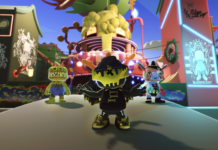The Evil Within has managed to generate quite a buzz since Bethesda and developer Tango Gameworks released the cinematic trailer a few weeks back — a trailer worthy of getting totally stoked over. It set the tone for what could be a great survival horror game from genre legend Shinji Mikami. I recently got an extended look at The Evil Within during a Bethesda media event, and while the game wasn't playable, several minutes of gameplay were showcased to help paint a clear picture of what players can expect.
Two things really stood out right from the get-go. The first was the beautifully dark atmosphere of the game. The brief outdoor sequence featured gothic architecture and a fittingly cloudy sky. Our protagonist Sebastian entered the building, but things switched to an equally brooding tone that now featured dim lighting reminiscent of horror flicks. This could all be considered the obvious visual direction for this type of game, but it's worth mentioning due to just how pure the style was to the horror genre.

The other thing that stood out to me was the definite Shinji Mikami vibe that's been incorporated into this game. Mikami was previously revealed to be the director behind this experience, and it definitely shows. From the over-the-shoulder view that harkens back to the Resident Evil franchise to the claustrophobic feel of the level design, the Mikami style is inherent throughout The Evil Within, and that's in no way a bad thing.
Aside from the director's distinctive approach, there are a variety of elements that help The Evil Within exude a grotesque and almost surreal style. One scene where Sebastian was trapped inside a room filled with hanging bodies sported blood splattered all over the walls, creating an unsettling environment for both the protagonist and the player. To make things even more insane, a shrouded character could be seen through the door as he hacked away at a victim. Oh, and while all of this was happening, Bach's beautiful musical piece “Air on the G String” played on, creating an even more distorted sense of insanity and torture.
As far as the actual gameplay is concerned, Evil Within approaches a more traditional survival horror design. From what I saw, the action wasn't that heavy, instead depending on the player to come up with ways to progress and thrive in the environment that aren't as direct as blowing an enemy's brains out. This included setting up traps for mobs of zombie-esque baddies, causing explosions as these creatures entered through windows, and hiding inside a tight locker while a massive chainsaw-wielding character chased after Sebastian.

These particular moments were especially intense because they had a cinematic edge to them that almost made me believe Sebastian wasn't going to make it out alive. Of course, I knew in the back of my head that he would because, well, otherwise this would be a very short video game. That said, the way the player character always had his back up against the wall as he dealt with these unreal forces created a sense of panic and fear that we don't really see too often in survival horror games, especially since dudes like Chris Redfield have access to huge guns and loads of bullets.
Speaking of bullets, the fact that The Evil Within focuses heavily on the classic survival horror tropes doesn't mean that there's a lack of guns. If you need to resort to firearms use, you can certainly do so. Just don't expect this to be some trigger-happy gun-fest. The game does supply you with some sturdy weapons, but because this is a Mikami endeavor, you won't be receiving a surplus of ammunition. Guns are to be used sparingly and in close quarters situations. If you're feeling overwhelmed due to an onslaught of enemies, for example, you can go for a couple of headshots (or the deliciously brutal kneecap shot) to get some breathing room or slow those bloodbathed jerks down.
Unlike the classic Resident Evil style, The Evil Within does let you move and shoot at targets. This is something we previously saw in another Mikami joint project, Shadows of the Damned. Having the ability to move around while firing a weapon comes in handy, and it helps create space between Sebastian and his aggressors. Still, the condensed space of the environments doesn't give you a lot of freedom, further developing on that desperate survivalist mentality.

The Evil Within will feature a linear plot and level flow, though there are some open-ended design choices. For example, certain scenarios will allow you to progress in multiple ways. Details of this aspect of the game were scarce during the preview session, but if The Evil Within really allows the player to take on different objectives in various ways, it could create a world that's worth returning to due to the sheer unpredictability of what each solution may offer.
It's clear that The Evil Within will likely provide a less action-heavy experience in favor of nerve-inducing survival horror elements, and that's definitely something to be excited about. If you dig the horror genre or consider yourself a fan of Mikami's work, this upcoming project is one worth keeping an eye on. The Evil Within is currently expected to launch in 2014, and it'll be available for the Xbox 360, PlayStation 3, PC, and next-gen hardware.
Want to talk about indie games, Kirby, or cheap pizza? Follow me on Twitter @dr_davidsanchez.










